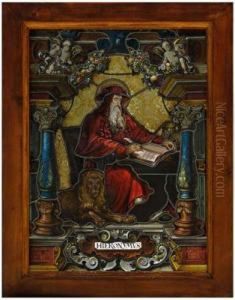Franz Xaver Zettler Paintings
Franz Xaver Zettler was an influential figure in the world of stained glass art, born in 1841 in Munich, Bavaria. He was a pivotal artist in the revival of stained glass in the 19th and early 20th centuries, a period that saw a resurgence of interest in medieval glass-making techniques and aesthetics. Zettler's work is characterized by its meticulous detail, vibrant colors, and the integration of Gothic and Renaissance influences, which he adeptly combined to create windows of profound beauty and spiritual depth.
After studying at the Royal Bavarian Academy of Fine Arts in Munich, Zettler honed his skills in the medium of stained glass, an art form that had seen decline in quality and popularity after the Middle Ages. In 1870, he founded the Royal Bavarian Art Institute for Stained Glass (Königliche Bayerische Hofkunstanstalt für Glasmalerei), which quickly became a leading center for stained glass production, not only in Germany but internationally. The institute attracted a number of talented artists and craftsmen, and under Zettler's leadership, it produced windows for churches, cathedrals, and other buildings across Europe, the United States, and beyond.
Zettler's approach to stained glass was innovative. He emphasized the importance of original design and the careful selection of glass, insisting on high-quality materials and the use of traditional glass-painting techniques. His works are notable for their elaborate figurative scenes, often depicting biblical stories, saints, and angels with a remarkable sense of life and movement. Zettler was also known for his ability to manipulate light through glass, creating luminous compositions that changed in appearance with the shifting sunlight.
Throughout his career, Franz Xaver Zettler received numerous commissions from religious and secular institutions alike. His windows can be found in some of the most prestigious locations around the world, serving as testament to his skill and vision. Despite the challenges posed by the industrial production of glass and changing artistic tastes, Zettler's dedication to the art form helped to ensure the survival and revival of stained glass as a high art.
Franz Xaver Zettler passed away in 1916, leaving behind a legacy that continues to influence the field of stained glass art. His institute carried on his work and principles after his death, further cementing his place as a key figure in the history of art. Today, Zettler's creations are celebrated for their artistic excellence and the significant role they played in the resurgence of stained glass art during a crucial period of its history.

